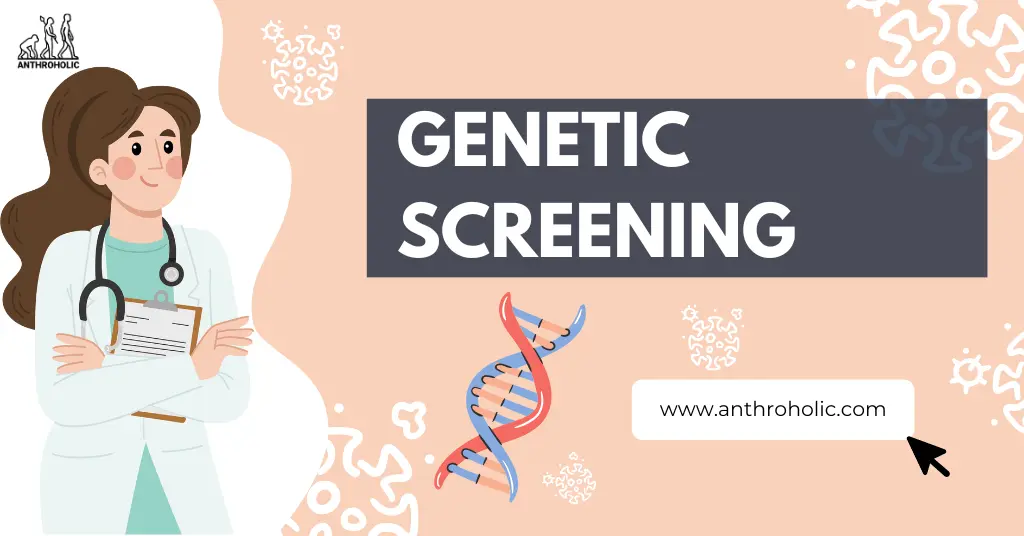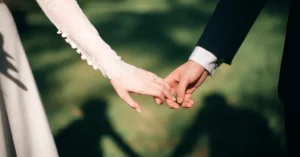AI Answer Evaluation Platform Live Now. Try Free Answer Evaluation Now
Genetic Screening
Genetic screening is a process used to identify variations or alterations in an individual’s genetic material (DNA) to assess their risk of developing certain genetic disorders or conditions. It involves analyzing an individual’s DNA sample, usually obtained from a blood sample or other biological materials, to detect specific genetic changes or mutations. The main goal of genetic screening is to identify individuals who may be at an increased risk of developing genetic disorders, allowing for early intervention, prevention, or management of these conditions.

Significance of Genetic Screening in Anthropology
Genetic screening has significant implications in anthropology, the study of human origins, evolution, and diversity. It provides valuable insights into the genetic makeup and diversity of human populations, shedding light on evolutionary processes, migration patterns, and the interplay between genetics and culture.
Here are some key aspects highlighting the significance of genetic screening in anthropology:
Population Genetics and Evolutionary History: Genetic screening allows researchers to study the genetic variation within and between populations. By analyzing specific genetic markers, such as single nucleotide polymorphisms (SNPs) or mitochondrial DNA (mtDNA), scientists can trace the ancestry and evolutionary history of human populations. These studies help unravel patterns of migration, genetic admixture, and population bottlenecks, contributing to our understanding of human evolution and the peopling of different regions.
Human Migration and Dispersal: Genetic screening provides valuable evidence for tracing ancient human migration and dispersal patterns. By comparing genetic markers across diverse populations, researchers can reconstruct the routes and timing of human movements throughout history. This has been particularly significant in understanding major migrations, such as the expansion of modern humans out of Africa and subsequent population interactions.
Disease Susceptibility and Genetic Adaptations: Genetic screening helps identify genetic variants associated with disease susceptibility or genetic adaptations in specific populations. Certain genetic variations can confer increased or decreased risk for certain diseases or conditions, and their prevalence can vary across populations. Studying these variations can shed light on the evolutionary forces that have shaped human genetic diversity and the role of natural selection in different environments.
Forensic Anthropology and Human Identification: Genetic screening plays a crucial role in forensic anthropology, aiding in human identification and ancestry determination. DNA analysis can be used to match unidentified human remains with missing persons, determine familial relationships, and provide insights into the genetic ancestry of individuals or populations [1].
Early Developments and Pioneering Studies:
Genetic screening has evolved over several decades, with early developments and pioneering studies laying the foundation for its application in various fields. Here are some key aspects of early developments and pioneering studies in genetic screening:
Newborn Screening: Newborn screening emerged as one of the earliest forms of genetic screening. The Guthrie test, developed by Dr. Robert Guthrie in the 1960s, was a pioneering study that focused on screening newborns for phenylketonuria (PKU), a metabolic disorder that can cause intellectual disability if left untreated [2]. The Guthrie test involved collecting blood from a newborn’s heel onto filter paper and analyzing it for elevated levels of phenylalanine. This early screening technique became the basis for expanded newborn screening programs worldwide.
Carrier Screening: Early studies in carrier screening aimed to identify individuals carrying genetic mutations that could be passed on to their offspring. The discovery of the sickle cell gene by Linus Pauling and his colleagues in the 1940s was a significant milestone in carrier screening. This led to the implementation of programs targeting at-risk populations for sickle cell anemia and other hemoglobinopathies.
Population Studies: Genetic screening played a crucial role in population studies, particularly in understanding the prevalence of genetic disorders in specific populations. For example, the pioneering work of James Neel in the 1960s investigated the high incidence of thalassemia in Mediterranean populations, which provided insights into the genetic basis and epidemiology of the disorder.
Evolution of Genetic Screening Techniques:
Over time, advances in technology have revolutionized genetic screening techniques, enhancing their accuracy, efficiency, and scope. Here are key milestones in the evolution of genetic screening techniques:
Polymerase Chain Reaction (PCR): The development of PCR by Kary Mullis in the 1980s revolutionized genetic screening. PCR enables the amplification of specific DNA sequences, allowing for the detection of genetic variations associated with various disorders. It has become a fundamental tool in genetic testing, enabling targeted analysis of specific genes or regions of interest.
Fluorescence In Situ Hybridization (FISH): FISH, developed in the 1980s, is a technique that uses fluorescent probes to visualize specific DNA sequences within cells. FISH has been widely used in genetic screening to detect chromosomal abnormalities, such as aneuploidies (e.g., Down syndrome) and structural rearrangements.
Microarray Analysis: Microarray technology, introduced in the 1990s, allows for the simultaneous analysis of thousands of DNA sequences. It enables the detection of copy number variations (CNVs) and single nucleotide polymorphisms (SNPs) associated with genetic disorders. Microarray analysis has found applications in carrier screening, prenatal diagnosis, and cancer genetics.
Next-Generation Sequencing (NGS): NGS technologies, also known as high-throughput sequencing, have revolutionized genetic screening in recent years. NGS allows for the rapid sequencing of millions of DNA fragments in parallel, providing comprehensive genetic information. It has transformed the field of genomics, enabling whole-genome sequencing, exome sequencing, and targeted gene panel testing for a wide range of genetic disorders.
Cultural and Social Factors Influencing Genetic Screening:
The implementation and uptake of genetic screening are influenced by various cultural and social factors. Here are some factors that play a role:
Cultural Perceptions and Beliefs: Cultural beliefs, attitudes, and perceptions regarding genetic disorders and screening can shape individuals’ and communities’ acceptance or resistance to genetic screening programs. Factors such as stigmatization, fear, religious or cultural beliefs, and the perception of disability may impact the uptake of genetic screening services.
Access to Healthcare: Socioeconomic factors, including access to healthcare services, can influence the availability and utilization of genetic screening. Limited access to healthcare, lack of awareness, and financial constraints may hinder individuals from accessing genetic screening services, particularly in underserved populations.
Ethical and Legal Considerations: Genetic screening raises ethical and legal concerns related to issues such as privacy, informed consent, genetic discrimination, and the potential impact on individuals, families, and communities. Cultural and societal values, as well as legal frameworks, shape the implementation and regulation of genetic screening practices.
Education and Awareness: The level of education and awareness about genetic disorders and screening can influence individuals’ understanding, attitudes, and decision-making regarding genetic screening. Educational campaigns, genetic counseling, and culturally appropriate information dissemination play a vital role in enhancing awareness and promoting informed choices.
Theoretical Frameworks in Anthropological Analysis of Genetic Screening
Medical Anthropology Perspectives: Medical anthropology provides a valuable framework for understanding the cultural, social, and ethical dimensions of genetic screening. It examines how genetic screening practices intersect with local beliefs, practices, and healthcare systems. Here are key aspects of medical anthropology perspectives on genetic screening:
Cultural Construction of Illness: Medical anthropology emphasizes that illness and disease are not solely biological phenomena but are also culturally constructed. Genetic screening is influenced by cultural beliefs and values surrounding health, illness, and genetics. Understanding cultural constructions of illness helps identify how genetic screening is perceived, accepted, or resisted in different communities.
Medical Pluralism: Medical anthropology recognizes that multiple healthcare systems coexist within societies, including traditional medicine, alternative therapies, and biomedicine. The introduction of genetic screening raises questions about how it interacts with existing healthcare systems and the negotiation of genetic information within diverse healing practices.
Social Determinants of Health: Medical anthropology highlights the role of social, economic, and political factors in shaping health outcomes. Genetic screening is not solely an individual decision but is influenced by broader social determinants, such as access to healthcare, socioeconomic disparities, and cultural norms. Examining these factors helps understand the impact of genetic screening on different populations.
Sociocultural Implications and Ethical Dilemmas
The anthropological analysis of genetic screening also examines its sociocultural implications and the ethical dilemmas it presents. Here are key aspects to consider:
Cultural Perceptions and Beliefs: Sociocultural factors shape individuals’ and communities’ understandings, interpretations, and acceptance of genetic screening. Cultural beliefs about genetics, inheritance, and notions of health and illness influence attitudes towards genetic screening and decision-making regarding its implementation.
Social Impact and Inequality: Genetic screening can have social consequences, including the potential reinforcement of existing inequalities. It raises questions about the implications of identifying individuals as carriers or being at risk for specific conditions, and the potential impact on family dynamics, social relationships, and community cohesion.
Reproductive Choices and Family Planning: Genetic screening, particularly prenatal screening, raises complex ethical dilemmas related to reproductive choices. It raises questions about selective abortion, decisions regarding reproductive technologies, and the broader social implications of reproductive decision-making in light of genetic information.
Cultural Appropriateness and Equity: The design and implementation of genetic screening programs should consider cultural appropriateness and sensitivity to diverse populations. Anthropological analysis addresses questions of cultural competency, ensuring that screening practices are respectful, inclusive, and tailored to the cultural and social contexts of the communities involved.
Technological Advancements and Innovations
Precision and Personalized Medicine: Technological advancements in genetic screening are leading towards precision and personalized medicine. The integration of genomic data with clinical information has the potential to enable tailored prevention, diagnosis, and treatment strategies based on an individual’s genetic profile.
Non-Invasive and Prenatal Screening: Advances in technology are facilitating the development of non-invasive prenatal screening methods that analyze fetal DNA from maternal blood samples. These techniques offer safer alternatives to invasive procedures and enable early detection of genetic abnormalities during pregnancy.
Single-Cell Genetic Screening: Single-cell genetic screening techniques are emerging as powerful tools to study genetic variation at the individual cell level. This allows for a deeper understanding of cellular heterogeneity, tumor evolution, and the identification of rare genetic variants associated with diseases.
Artificial Intelligence and Big Data Analysis: The integration of artificial intelligence (AI) and machine learning algorithms with genetic screening data holds promise for improving data analysis, interpretation, and prediction of disease risk. AI can help identify complex patterns, genetic interactions, and biomarkers associated with specific conditions, contributing to more accurate diagnoses and targeted interventions.
Policy and Regulatory Frameworks
Harmonization and Standardization: As genetic screening becomes more widespread, there is a need for harmonization and standardization of policies and guidelines. International collaboration is crucial to ensure consistent standards for quality assurance, data privacy, informed consent, and reporting of genetic screening results.
Data Sharing and Integration: The sharing and integration of genetic data across research institutions and healthcare settings raise ethical and legal challenges. Developing robust policies and frameworks for data sharing, while safeguarding individual privacy and confidentiality, will be essential for advancing genetic screening research and practice.
Regulation of Direct-to-Consumer Genetic Testing: Direct-to-consumer genetic testing (DTCGT) allows individuals to access genetic screening without involvement of healthcare professionals. The regulation of DTCGT services is an ongoing challenge, as it involves balancing consumer autonomy with the need for accurate interpretation and counseling of genetic information.
Ethical Guidelines and Practices
Informed Consent and Genetic Counseling: Ensuring informed consent and access to genetic counseling services is critical. Genetic counseling provides individuals with accurate information, helps them understand the implications of genetic screening, and supports decision-making regarding genetic testing, disclosure of results, and family planning.
Genetic Discrimination and Stigmatization: Ethical guidelines should address concerns related to genetic discrimination and stigmatization based on genetic information. Policies and legislation should protect individuals from discrimination in employment, insurance, and other domains based on their genetic characteristics.
Equity and Access: Efforts are needed to ensure equitable access to genetic screening services across diverse populations, including underserved communities. Addressing healthcare disparities and promoting cultural competence are vital to prevent further exacerbation of existing health inequities.
Long-term Follow-up and Psychosocial Support: Genetic screening can have long-term implications for individuals and families. Ethical guidelines should emphasize the provision of long-term follow-up care, psychosocial support, and education to individuals and families affected by genetic conditions identified through screening.
References
[1] Reich, D., & Green, R. E. (2015). Genetic history of human populations. In The Princeton Guide to Evolution (pp. 394-399). Princeton University Press.
[2] Guthrie, R., & Susi, A. (1963). A Simple Phenylalanine Method for Detecting Phenylketonuria in Large Populations of Newborn Infants. Pediatrics, 32(3), 338-343. https://pubmed.ncbi.nlm.nih.gov/14063511/




